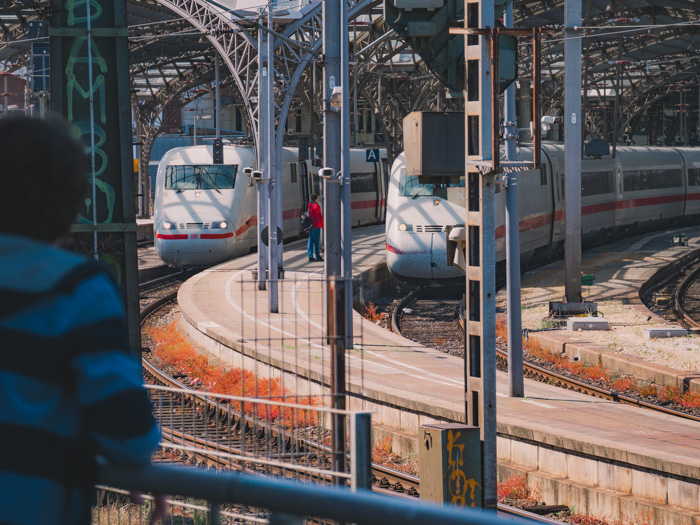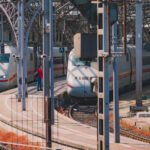You might have heard that in the summer of 2022 it was possible to travel all over Germany for only € 9 a month. If not; yes, really, it’s true! It was a brilliant way to let people discover the joy of train travel and promote this more sustainable way of travel. The € 9 ticket is gone, but that doesn’t mean that Germany isn’t an interesting country to travel. I took advantage of the ticket and discovered places in Germany that I never imagined I would find. So, to make it easy on you to explore Germany by train, I’ve created this mini Germany train travel guide for you.
Hi, I’m Lizet from Awanderfoodworld, a sustainable travel blog. Jessica called upon my train travel expertise to help you explore the beautiful country of Germany! This country is super easy and fun to explore by train, so let me explain how.
Why should I travel through Germany by train?
Like I said, I bought that € 9 ticket and explored quite a bit of Germany. So, let me start by telling you why you would want to as well. This country just has so much to offer. Before my German train trip, I had only seen a few cities, mostly Berlin a few times. Although I love Berlin and gladly visit it over and over, I will always be more of a nature or small-town person. My view of Germany was that of big cities, mostly with brand-new buildings, as so much was destroyed during the war.
But I was so incredibly wrong! Germany has everything a country can have. It has the cute towns that luckily survived the destruction during the war, with the endless little streets with old historic buildings still standing strong. And it has some of the most amazing nature I’ve seen. With Switzerland and Austria as neighbouring countries, the mountains in the South of Germany so often get overlooked. Having been to Austria as well, I can confirm now that Germany is a proper competitor when it comes to their mountains, stunning blue lakes, and thick forests.
So, are you ready for your own German train adventure? Let me help you with all you need to know about the German train system.
Train Travel in Germany 101
Let’s start with the basics. In Germany, you basically have 1 big train operator, the Deutsche Bahn. They operate on about 96% of the long-distance routes and 72% of the regional trains (in 2019). Convenient for you if you’re planning a train trip in Germany, as you’ll be able to buy all your tickets through DB.
Long-distance and regional trains.
The trains can be divided in a few different categories, the long-distance trains and the regional ones. The regional trains are often a bit slow because they stop at the smallest locations. You’ll find them in the countryside, but also in between 2 cities. Considering, people also need to get to their homes in the small towns in between those cities. These trains are sometimes cheaper but take longer because of all the stops. When searching for trains, you’ll recognize these as:
- RB – Regiobahn, stops everywhere
- RE – RegioExpress, makes fewer stops and is a bit faster
- IRE – Longer distance but still with many stops. With this one, it’s often advised to swap to a faster train at a bigger train station, if possible.
In some regions of the country, you might find different names because there are a few regional train operators. But the concept will be the same, short distance with numerous stops at small stations.
A faster, and often more expensive, option is to take the longer distance trains that only stop at bigger stations. You can recognize these as:
- IC – Intercity, Fast trains connecting bigger cities in Germany
- EC – EuroCity, a fast train that also crosses the borders. Often to border stations like Salzburg or Strasbourg as the end station
- ICE – IntercityExpress, international trains connecting big cities from different countries. So, for example, Berlin to Amsterdam. These often don’t make stops in between or only in 1 or 2 places (like Hamburg, in between Berlin and Amsterdam). You will see the ICE trains in different countries in Europe.
- ICE-S – Same as ICE, but limited to Germany. As it’s such a big country, it’s great to have a superfast train from Berlin to Munich that connects North and South in just a matter of hours.
- For night trains you have the EN (EuroNight) and CNL (City Night Line), both go international, the latter also does night trains within the country.
- As a non-DB operated alternative, you have the FlixTrain, from the same company as the FlixBus. This is often a cheap alternative to the fact IC and ICE trains and runs between big German cities, as well as a few international routes. For example, from Hamburg to Prague.
City transport
And then finally, you’ll see S and U, which aren’t trains, but they’ll pop up on booking platforms from time to time. They are the city transport options. The S-bahn is the tram and will sometimes have a separate track in the train station. It’s indirectly also operated by DB, so it’s often a great connection to the train. The U-bahn is the “underground”, metro, subway, whatever name you want to give it. This isn’t operated by DB.
Which train do I need for my train trip?
Which train you need for your trip, depends. If you’re travelling in the countryside, or you’re staying in a small-town outside the big cities, you’ll need a regional train. In between big cities, you can take the fast, long-distance trains.
But honestly, it doesn’t really matter. These names are just good to know for when you see them both. If you’re looking for a route, and you get the option to go for an IC or an RE for example, you’ll just know that the RE will stop more often and is probably slower. This can also help you understand why one of them would be cheaper and help you decide which one is worth your money. The FlixTrain is generally the cheapest. But as they operate much less than DB, they aren’t widely available and, unfortunately, often tend to be late because DB gets priority on the tracks.
Are German trains reliable?
Honestly, I’ve heard so many complaints about the German train system and I simply don’t relate. The € 9 ticket situation was a big disaster, but how could it not be? Who won’t travel by train if it’s only € 9 for a whole month? The trains were just so overloaded, the system couldn’t handle it. But my other experiences with German train travel were perfectly fine. Sure, they’re not always on time and delays happen. But I’m not going to complain about it being unreliable if I occasionally have a 10-minute delay. I do, however, advise you to always give yourself some time for a transfer, just in case you do have a delay.

How do I book my train tickets in Germany?
As DB runs the majority of the trains, you can book pretty much any ticket through their website. Aside from the FlixTrain and the city transport. Even if you’re switching to regional trains that aren’t operated by DB, you will be able to book your tickets through the DB website or app. And the same goes for buses, if you ever make it past the end of the train tracks.
I really like this aspect of DB because they really tried to make it as easy as possible for train travellers to get around Germany, instead of having you figure out in which regions they might not operate. You can even buy loads of tickets from and to different countries around, including The Netherlands, France, Italy, and Austria. From The Netherlands, this has saved me tons of money already! So, if you’re coming from any European country, it’s worth checking if the prices on the DB website are cheaper than on your local international train operator.
Extra booking possibilities
The DB website and app are great and offer tons of extra features. You can select your preferred transfer time. If you know you don’t walk too fast or worry about missing a transfer, you can choose to have a minimum of 20 minutes transfer time, for example. Or choose for direct connections only, without any transfers at all. You can also exclude certain means of transport, like regional trains, if you only want the fast trains. And you can guide the route a certain way. Want to make a stop in a specific place? Just fill in a “via” location, and it will give you routes that will pass that destination.

How to find the cheapest tickets?
If you search for German train tickets, you might be shocked at the prices. But they don’t have to be expensive at all. There are a few ways to get the cheapest tickets:
- Book early! DB posts their train schedule 6 months ahead and at that point the prices are lowest. It’s a supply and demand system, the first tickets will go for discount prices and the last pieces go for sky-high prices. Especially if you book them last minute. So, ideally, you want to book your tickets 6 months ahead.
- Be flexible. As with everything tourism related, prices differ between high and low season. But it can also differ per hour of the day. High traffic times are often way more expensive. So, sometimes it could be half the price if you’re willing to leave at 6am or arrive at 11pm.
- Check the discounts, as DB ofters them regularly. In January, they have a big campaign for it, but throughout the year you can find cheap tickets as well. It’s called “Super spärreise” and could get you € 17.90 tickets for the Munich to Salzburg train, for example.
- Buy a discount card. The chances of the € 9 ticket coming back, ever again, are pretty slim. But they did come with a perfectly reasonable alternative: a € 49 ticket for a month long unlimited German train travel. With the only limitation being that it’s only valid on the slower regional trains (and city transport). So, no fast trains across the country. But who cares, if you’re on holiday, right?
Are you excited about a German train travel adventure?
I hope this mini guide gave you plenty to go on in planning your German train travel. But the next step is of course, to figure out where to go. In case you’d need any inspiration on that, I got you covered! I wrote a train travel guide on my Southern Germany trip with all the cool places I’ve visited plus many many more. This will make it super easy for you to plan an amazing German train trip.












